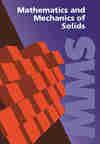Stochastic mesoscale mechanical modeling of metallic foams
IF 1.7
4区 工程技术
Q3 MATERIALS SCIENCE, MULTIDISCIPLINARY
引用次数: 0
Abstract
Investigating the mechanical properties of complex, porous microstructures by assessing model representative volumes is an established method of determining materials properties across a range of length scales. An understanding of how behavior evolves with length scale is essential for evaluating the material’s suitability for certain applications where the interaction volume is so small that the mechanical response originates from individual features rather than a set of features. Here, we apply the Kentucky Random Structure Toolkit (KRaSTk) to metallic foams, which are crucial to many emerging applications, among them shielding against hypervelocity impacts caused by micrometeoroids and orbital debris (MMOD). The variability of properties at feature-scale and mesoscale lengths originating from the inherently random microstructure makes developing predictive models challenging. It also hinders the optimization of components fabricated with such foams, an especially serious problem for spacecraft design where the benefit–cost–mass optimization is overshadowed by the catastrophic results of component failure. To address this problem, we compute the critical transition between the feature-scale, where mechanical properties are determined by individual features, and the mesoscale, where behavior is determined by ensembles of features. At the mesoscale, we compute distributions of properties—with respect to both expectation value and standard variability—that are consistent and predictable. A universal transition is found to occur when the side length of a cubic sample volume is ~10× greater than the characteristic length. Comparing KRaSTk-computed converged stiffness distributions with experimental measurements of a commercial metallic foam found an excellent agreement for both expectation value and standard variability at all reduced densities. Lastly, we observe that the diameter of a representative MMOD strike is ~30× shorter than the feature-scale to mesoscale transition for the foam at any reduced density, strongly implying that individual features will determine response to hypervelocity impacts, rather than bulk, or even mesoscale, structure.金属泡沫的随机中尺度力学建模
通过评估模型代表体积来研究复杂多孔微结构的机械特性,是确定各种长度尺度材料特性的既定方法。在某些应用中,相互作用体积非常小,机械响应源自单个特征而非一系列特征,因此了解材料行为如何随长度尺度变化对于评估材料是否适用至关重要。在这里,我们将肯塔基随机结构工具包(KRaSTk)应用于金属泡沫,金属泡沫对许多新兴应用至关重要,其中包括屏蔽微流星体和轨道碎片(MMOD)造成的超高速撞击。由于微观结构本身具有随机性,因此在特征尺度和中尺度长度上的属性变化使得开发预测模型具有挑战性。这也阻碍了对使用此类泡沫制造的组件进行优化,对于航天器设计来说,这是一个尤为严重的问题,因为在航天器设计中,组件失效的灾难性结果会使效益-成本-质量的优化黯然失色。为了解决这个问题,我们计算了由单个特征决定机械性能的特征尺度与由特征集合决定行为的中尺度之间的临界过渡。在中尺度上,我们计算出的属性分布--在期望值和标准变异性方面--都是一致且可预测的。当立方体样品体积的边长大于特征长度约 10 倍时,就会发生普遍的转变。将 KRaSTk 计算出的收敛刚度分布与商用金属泡沫的实验测量结果进行比较后发现,在所有密度降低的情况下,两者的期望值和标准变异性都非常一致。最后,我们观察到,在任何密度降低的情况下,具有代表性的 MMOD 撞击的直径都比泡沫的特征尺度到中尺度的转变短 ~30倍,这强烈暗示了单个特征将决定对超高速撞击的响应,而不是整体结构,甚至是中尺度结构。
本文章由计算机程序翻译,如有差异,请以英文原文为准。
求助全文
约1分钟内获得全文
求助全文
来源期刊

Mathematics and Mechanics of Solids
工程技术-材料科学:综合
CiteScore
4.80
自引率
19.20%
发文量
159
审稿时长
1 months
期刊介绍:
Mathematics and Mechanics of Solids is an international peer-reviewed journal that publishes the highest quality original innovative research in solid mechanics and materials science.
The central aim of MMS is to publish original, well-written and self-contained research that elucidates the mechanical behaviour of solids with particular emphasis on mathematical principles. This journal is a member of the Committee on Publication Ethics (COPE).
 求助内容:
求助内容: 应助结果提醒方式:
应助结果提醒方式:


